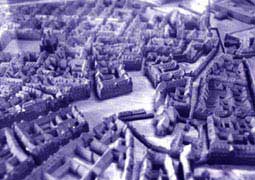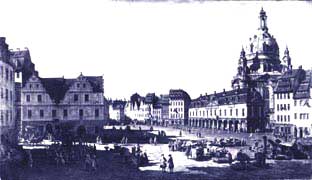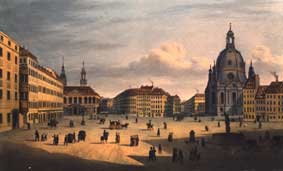
cityplan 1529
|
Originally
the area of the present Neumarkt was not part of the city of Dresden.
Situated in front of the citywall and the "Frauentor" was
the Gothic church "Unsere Lieben Frauen" and its graveyard
(lower left in the picture). Various roads branched off in an eastern
direction from this little irregular square, such as the Pirnaische
Straße and the Rampische Straße. Only the Juedenhofwas
located inside the fortifications.
 |
|
During
the Renainssance the appearance of Dresden was a greatly changed.
The capital city of Saxony which had become the principal resdidence
of Duke Moritz expanded so that the area of the Neumarkt became the
part of the municipal area in 1548. An extravagant fortifications
system with a city wall and a moat was built to defent the city from
any oncoming attack. During this period the future structure of the
Neumarkt began to evolve. Magnificent renaissance houses like the
old Gewandhaus located on the former city wall influenced the appearance
of the square.
But until the eighteenth century, the large graveyard of the old gothic Frauenkirche considerably reduced the size of the square. Among the political events the execution of the reformist, calvinistic, Saxonian chancellor Krell at the Jüdenhof on the 9th of October 1601 is outstanding. |
|
Early
Baroque Era
 Bernardo Bellotto, The Neumarkt in Dresden as seen from the Moritzstrasse (1750) |
|
The
famous, fully evolved townscape of the neumarkt as a complete work
of art was created during the golden age of Augustus the Strung during
the early eighteenth century. By means of strict regulations concerning
the number of stories, the arrangement of the facades and the material
uses for the buildings, a most mature sence was created and is one
of the greatest achievements of baroque civic architecture. The large
paintings of Bernardo Belotto (Canaletto) shows us in a clear and
vivid way the low buildings of the Renaissance standing side by side
with the four five store houses of the bouregoisie.
The left side of the picture shows the Gewandhaus which was torn down in 1791 to make way for a planned symmetrical baroque square. The Altstaedter Wache was located in front of the Frauenkirche and prewented a complete view of the monumental dome as an entire unit ... |
|
Late
Baroque Era after 1760
 Neumarkt with the Frauenkirche as seen from the south (1820) |
|
During
the Seven Years War (1756 - 1763) the Neumarkt was badly damaged by
Prussian troops. Almost the complete Pirnaische Vorstadt and with
it a large part of the eastern Neumarkt burnt down after heavy artillery
shelling on July 19th, 1760. Considering the traditional structure
of the plots the destroyed areas were reconstructed in the plain and
moderate design of the Dresden late baroque style. Compared to the
rather irregulary laid out square before 1760, the Neumarkt in the
late baroque period, now without the Gewandhaus and the Hauptwache
(the ruins of which having been torn down in 1766), displayed a sense
of perfect harmony and clarity.
|
|
The Frauenkirche  The Neumarkt, view towards the Frauenkirche (1931) |
|
The
erection of the Frauenkirche marked the change in the history of the
Neumarkt. As the central building, it was exactly "adjusted"
to the irregular appearance of the square. The church and square merged
into a unit.
Without the Frauenkirche, built by George Baehr, the Dresden Neumarkt would never have achieved such a tremendous importance in the art of European urban development. Not only did its stone dome dominante the skyline of the old town, it also completed the picturesq ue view of the narrow alleys around the Neumarkt. Only the Frauenkirche built between 1726 - 1743 as a monument to Protestant beliefs and bourgeois sensibilities gives structure to the Neumarkt. Reconstruction has been going on since 1994 and is to be completed for the 800th anniversary of Dresden in 2006 incorporating elements of the ruins and stones retrieved from the rubble. |
|
19th century  Robert Wehle, The Neumarkt with the Frauenkirche, 1847 |
|
During
the nineteenth century there were only a few changes at the Neumarkt
apart from two new buildings in neorenaissance style. One of them
was the "Au petit Bazar", the first department store in Dresden,
erected in 1851 by von Bothen with big display windows at the corner
of Neumarkt/ Frauenstraße. The important historical townscape of
the Neumarkt remained preserved in its well-balanced urban composition
until 1945.
The
destruction of Dresden began on the 9th of november 1938, when the
worked up national socialists all over Germany set fire to the synagoges,
thus also the one in Dresden by Gottfried Semper. After World War
II which was started by Hitler Germany and resulted in millions
of deads, the fire returned to the German Reich. In February 1945
the art historically highly important Dresdner city centre was turned
into a heap of ruins. The space round the admonitory ruin of the
Frauenkirche remained unbuilt for decades. Admittedly the GDR government
made a big effort to reconstruct some of the monumental buildings
of historical heritage, such as the Johanneum, the Royal Mews, the
House of the Estates, the Academy of Arts, the Albertinum and the
Landhaus. On the other hand several facades which could have been
reconstructed, such as the Rampische Gasse were deliberately blown
up.
21th
century On
30 October 2005 the Dresdner Frauenkirche was reconsecrated by the
Saxonian regional bishop Jochen Bohl with worldwide media attention.
After the reconstruction of the gorgeous baroque church has been
completed, the urban sorroundings also emerge at a surprisingly
fast speed. Dresden is recovering its old town centre with a pioneering
mixture of tradition and modern. It its our hope that love for our
native city and an open mind towards the world will characterize
the square in a united, peaceful Europe of the 21th century.
|

